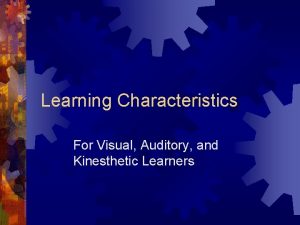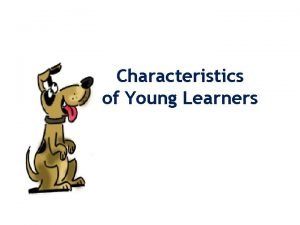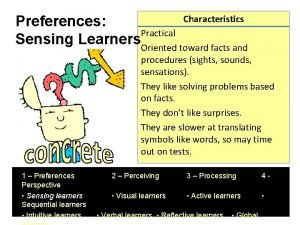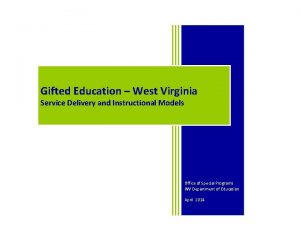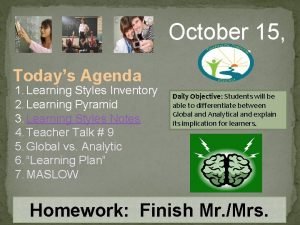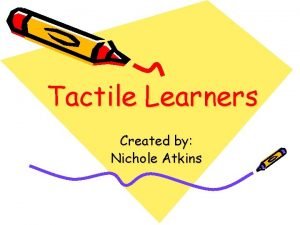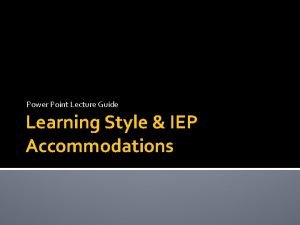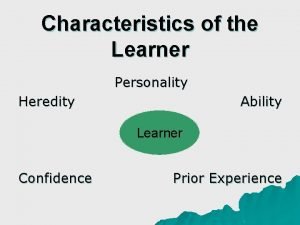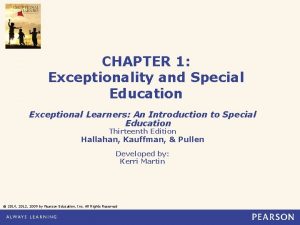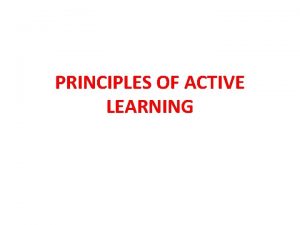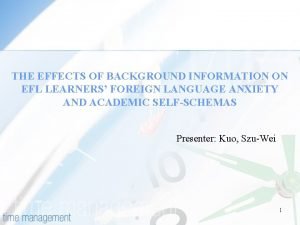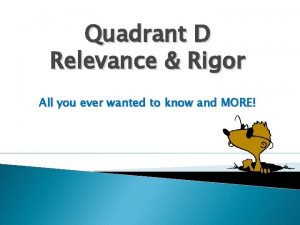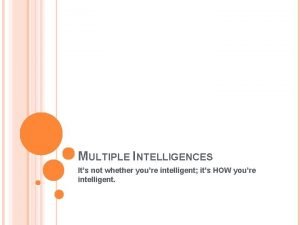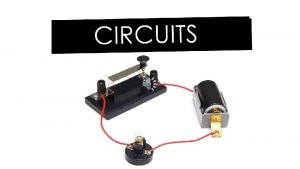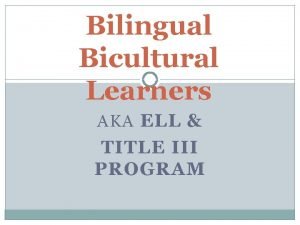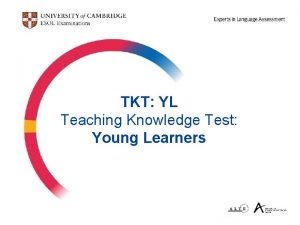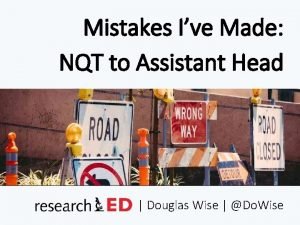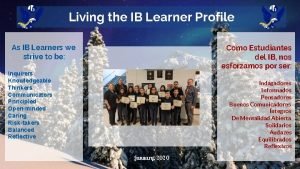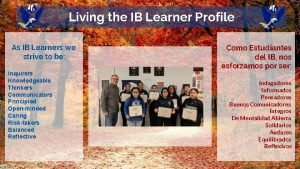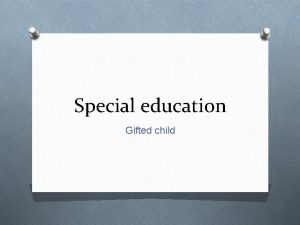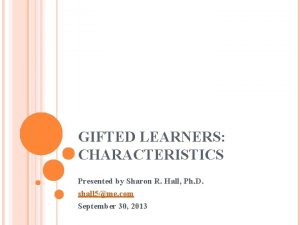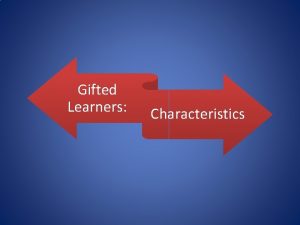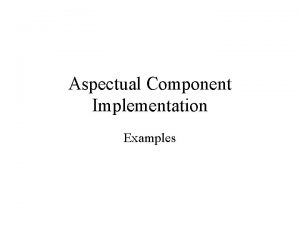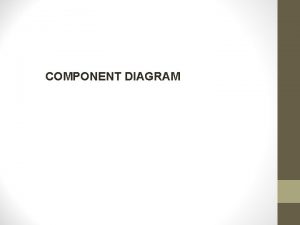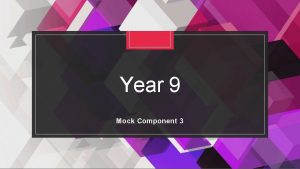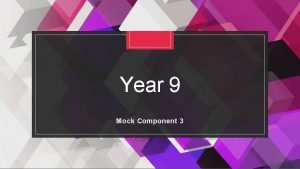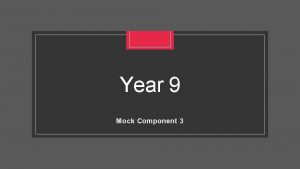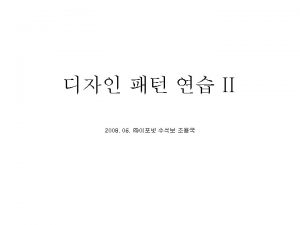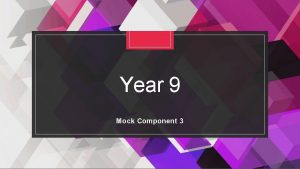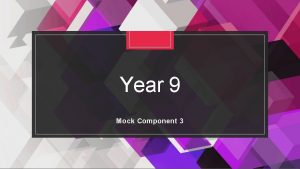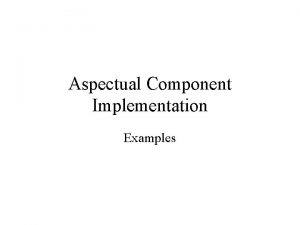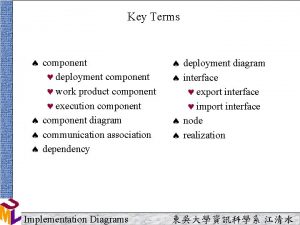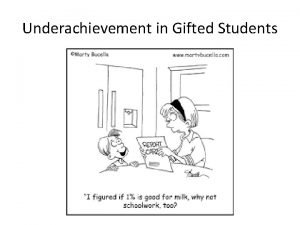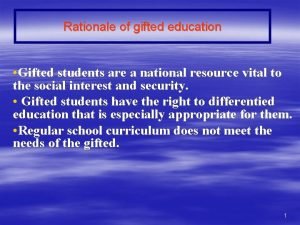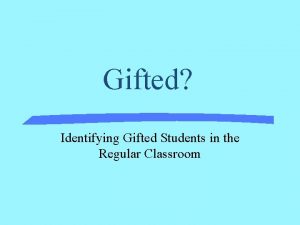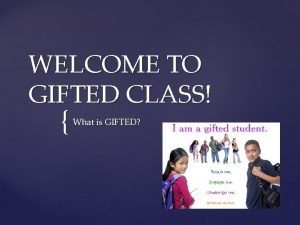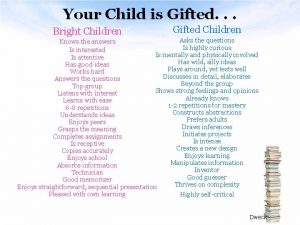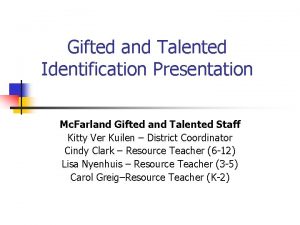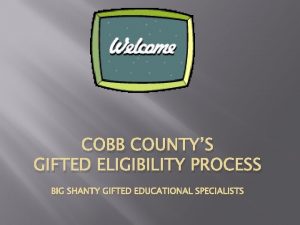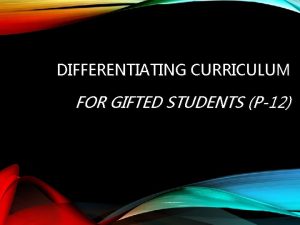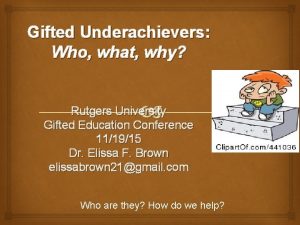Characteristics of Gifted Learners Component 3 of the































- Slides: 31

Characteristics of Gifted Learners Component 3 of the Competencies Collaboration SEVA Council of Gifted Administrators

Characteristics of Gifted Learners

Table of Contents n n Characteristics of Gifted Learners Possible Concomitant Characteristics The Twice-exceptional Learner Underrepresented Populations VBCPS Office of Gifted Education and Curriculum Development 2012

Reflection Questions Do you Agree or Disagree with the following statements? n Gifted students are often alike. n Gifted means the same thing as talented. n Gifted students who misbehave are not truly gifted. n Students with learning disabilities cannot be in need of gifted services. n Students are easy to identify for gifted services. n Students are identified for gifted services because of characteristics that indicate a need for services and activities not ordinarily provided by the school. VBCPS Office of Gifted Education and Curriculum Development 2012

Definition of Giftedness “Students, children, or youth who give evidence of high achievement capability in areas such as intellectual, creative, artistic, or leadership capacity, or in specific academic fields, and who need services and activities not ordinarily provided by the school in order to fully develop those capabilities. ” ~The United States Elementary and Secondary Education Act (NCLB) VBCPS Office of Gifted Education and Curriculum Development 2012

“Gifted” and “Talented” n The terms are used interchangeably by many n ‘Talented’ tends to refer to individuals with abilities in the arts n ‘Gifted’ often refers to abilities in academia n The VA Gifted Regulations refer only to giftedness and not talents, but students may be identified as gifted in visual and performing arts VBCPS Office of Gifted Education and Curriculum Development 2012

A teacher’s understanding of characteristics and behaviors of gifted students will: Assist in identification Support affective needs VBCPS Office of Gifted Education and Curriculum Development 2012 Support cognitive needs

Some Learning Characteristics of Gifted Children and Adolescents Characteristics of Gifted Learners Possible Concomitant Problems and Implications Characteristics can manifest themselves in positive ways or in ways that may create problems for gifted learners in a classroom. Due to the nature of gifted learners, both achievers and underachievers, it becomes necessary to recognize that each one of these characteristics may be present in varying degrees. VBCPS Office of Gifted Education and Curriculum Development 2012

• • Characteristics Keen power of observation; naive receptivity; sense of the significant; willingness to examine the unusual Powers of abstraction, conceptualized, synthesis; interest in inductive learning and problem solving; pleasure in intellectual activity Interest in cause-effect relations and ability to see relationships; interest in applying concepts; love of truth Liking for structure and order; liking for consistency, as in value systems, number systems, clocks, calendars Retentiveness Verbal proficiency; large vocabulary; facility in expression; interest in reading; breadth of information in advanced areas Questioning attitude, intellectual curiosity, inquisitive mind, intrinsic motivation Power of critical thinking; skepticism, evaluative testing, self-criticism and selfchecking VBCPS Office of Gifted Education and Curriculum Development 2012 Possible Concomitant Problems • Possible gullibility • Occasional resistance to directions; rejection or omission of detail • Difficulty in accepting the illogical • Invention of own systems, sometimes conflicting • Dislike for routine drill • Need for specialized reading vocabulary early; escape into verbalism • Lack of early home or school stimulation • Critical attitude toward others; discouragement from self-criticism

Concomitant Problems Characteristics • • Creativeness and inventiveness; a liking for new ways of doing things; interest in creating, brainstorming, freewheeling Power of concentration; intense attention that excludes all else; long attention span Persistent, goal-directed behavior Sensitivity, intuitiveness, empathy for others; need for emotional support and a sympathetic attitude • High energy, alertness, eagerness; periods of intense voluntary effort preceding invention • Independence in work and study; preference for individualized work; selfreliance, need for freedom of movement and action Versatility and virtuosity; diversity of interests and abilities; many hobbies • • Friendliness and outgoingness VBCPS Office of Gifted Education and Curriculum Development 2012 • Rejection of knowledge; need to invent for oneself • Resistance to interruption • Stubbornness • Need for success and recognition; sensitivity to criticism; vulnerability to peergroup rejection • Frustration with inactivity and absence of progress • Parent and peer-group pressures and nonconformity; problems of rejection and rebellion • Lack of homogeneity in group work; need for flexibility and individualization; need for help in exploring and developing interests • Need for peer-group relations in many types of groups; problems with social leadership

n It is much like two sides of the same coin: some gifted characteristics are exhibited in ways that may be considered counterintuitive. When these behaviors are demonstrated by students, they may be perceived as negative when, in fact, they could be indicators of giftedness. n For example, a student who likes consistency and structure may invent and insist upon his/her own way of doing things which may be consistent but in conflict with what is required. n When non-productive behaviors arise in a classroom, it is important to look at the causes of the behaviors, rather than just at the behaviors.

Learning Needs Based on Gifted Characteristics Characteristic Learning Need Excellent memory Access to large quantities of information Advanced comprehension Challenging learning activities Varied interests (multipotentiality) Exposure to a wide range of topics and ideas Excellent verbal skills Opportunities for in-depth discussion and reflection Flexibility and creativity of thought processes Challenging and varied problem solving activities Accelerated rate of thinking Individually paced learning Goal-oriented focus Extended time for specific learning activities

Learning Needs Based on Gifted Characteristics, cont. Characteristic Learning Need Independence in learning Independent and self-directed learning tasks Analytical thinking Opportunities for high-level thinking and problem solving; “time to think” Self-motivation Active involvement in learning and setting goals for learning Emotional sensitivity Opportunities for reflection Interest in adult issues Exposure to real world issues Abstract and holistic reasoning Multidisciplinary approach to learning Voracious reader Access to extensive and diverse resources Adapted from materials from State of Victoria, Australia

Creativity Characteristics of creative students may include: n openness to experience n setting personal (unique) standards for evaluation n ability to play with ideas n willingness to take risks n preference for complexity n tolerance for ambiguity n the ability to become submerged in a task Creativity is not just about talent in the arts! Consider how classroom experiences can enhance these productive behaviors. Consider referring these students for gifted services if you see repeated evidence of these characteristics. Source: ERIC EC Digest #E 476 (1990) ERIC Clearinghouse VBCPS Office of Gifted Education and Curriculum Development 2012

Perfectionistic and Underachieving Gifted Students Characteristics of perfectionistic gifted students may include: n Showing reluctance beginning a task n Starting work over often and working slowly to avoid mistakes n Having difficulty completing assignments on time n Being needy of teacher attention and crying easily when frustrated n Arguing and defending in response to teacher comments Underachieving gifted students: n May not see the philosophical need to complete assignments n May feel unmotivated by required work that does not hold their interest or challenge them n May sometimes be afraid to fail and so never begin Adapted from work by Susan Winebrenner

Bright student or gifted student? Helping parents understand why their prodigy might not be identified as gifted… Bright student Knows the answers Is interested Has good ideas Works hard Answers the questions Is in the top group Listens with interest Learns with ease Requires 6 -8 repetitions for mastery Enjoys peers Grasps the meaning Copies accurately Enjoys school Absorbs information Is a technician Enjoys sequential learning Gifted Student Asks the questions Is highly curious May have wild, silly ideas May play around, yet tests well Discusses in detail, elaborates Goes beyond the group May show strong feelings/opinions Already knows May require little repetition Prefers adults Draws inferences Creates a new design Enjoys learning Manipulates information Is an inventor Thrives on complexity -J. Szabos

Something to think about… How do these attributes emerge in your classroom? What implications do these attributes have when identifying students in need of gifted services?

Twice-exceptional Learners (also referred to as students with dual exceptionalities) ce n a m r o perf h g i h g n i t a r t s demon academic and/or artistic also has a permanent or tempora behavioral ry cognitive , or emotio , physical, nal disabili ty es c i v r e s d e t a i nt l e a i r t e n f f e i t o p sd r d e e h e / N is h t e e to m VBCPS Office of Gifted Education and Curriculum Development 2012 Source: Unraveling the Mystery of a Paradox: The Twice-Exceptional Child (2006)

The Paradox of Twice-exceptional Learners Signs of Giftedness Signs of Learning Disabilities ~excellent long-term memory ~poor short-term memory ~extensive vocabulary ~speaking vocabulary more sophisticated than written ~ excels in reading comprehension ~struggles with decoding words ~excels in mathematical reasoning ~has difficulty with computation ~advanced verbal skills in discussions ~refuses to do written work ~facile with computers ~handwriting is illegible ~grasps abstract concepts ~has difficulty with spelling and phonics ~performs better with challenging work ~struggles with sequential material ~thrives on complexity ~has difficulty with rote memorization ~highly creative, imaginative ~often inattentive in class ~reasons well ~emotions can overpower reasoning ~is a keen observer ~poor auditory memory ~poor listening skills Source: Linda Kreger Silverman, Ph. D Gifted Development Center © 1997 -2011 VBCPS Office of Gifted Education and Curriculum Development 2012

Gifted Students with Asperger’s Syndrome (Autism Spectrum Disorder) Students with Asperger’s Syndrome may be highly verbal, have obsessive interests in certain subjects, have exceptional memories, usually have above average IQ's, are hypersensitive to sensory stimuli and experience social isolation. Gifted individuals can manifest these behaviors as well. However, even though children with Asperger's Syndrome manifest behaviors that are very similar to gifted children, upon closer examination, the motivation for the behaviors is quite different. For example, both gifted children and children with Asperger's Syndrome are highly verbal. Both populations usually have extremely advanced vocabularies and love to talk about their interests. The difference is that children with Asperger's are very literal and have a difficult time with abstract thought. This is not the case with the gifted child. The child with Asperger's will memorize a vast number of facts and parrot them back. The gifted child on the other hand, understands the concepts behind the words. Cindy Little, 2002

Distinctions between characteristics of gifted students and gifted students with Asperger’s Syndrome Differentiating Characteristic Gifted Student Gifted with Asperger’s Syndrome Response to routines May passively resist, but go along Low tolerance for change in routines Social Interaction May be socially isolated May be socially inept Humor Understands, uses humor in social situations Does not reciprocate humor Insight Usually very good Social insight often absent Interests and knowledge base Highly focused interests, extensive knowledge base Cognition Advanced understanding Empathy for others and for Empathy for abstract whole; abstract whole difficulty with empathy for others Advanced memorization

Gifted Students with ADHD and gifted students responding to an inappropriate curriculum may have very similar characteristics, and a student may be both gifted and ADHD. Here is a brief description of their behaviors. Bored Gifted Students with ADHD Poor attention, daydreaming Poorly sustained attention Low persistence on irrelevant tasks Low persistence on tasks without immediate consequences Begin many projects, complete few Shift from one incomplete project to another High activity level High activity, restlessness Highly sensitive to criticism Problems exist only in some situations Problems persist across many situations Questions rules, regulations Has difficulty adhering to rules May appear disorganized May appear forgetful, losing items Intense Impulsive Adapted from work by Carol Bainbridge

A Parent’s Perspective For a student who is gifted and has a learning disability, it means being bored to tears in math and science classes because they are too easy, while struggling to read grade-level books. It means not being able to read books that discuss science and other topics at his level of understanding. It means finding reading class books challenging, but the classroom discussions excruciatingly boring. It means having his hands get cramped and tired after only one page of writing. It means being unable to write and think at the same time, so that his written work doesn't come anywhere near reflecting the depth of his thoughts. It means he is thinking about math concepts that his teachers don't understand, but having trouble writing them down. For a student who is gifted and has ADHD, it means getting assignments wrong because he missed some of the instructions and therefore did the wrong thing correctly. It means getting into trouble for not paying attention because he is incapable of focusing on multi-step oral instructions, but seems too smart to not understand what he is supposed to do. It means getting in trouble for losing control at the end of the day, when he is tired and his medication has worn off, because "you're too smart to forget the rules". -Lee Singer

§ It is important to note that for the twice-exceptional learner, his or her own unique combination of characteristics means that an area of giftedness may mask a disability or a disability mask an area of giftedness. § While a disability mask giftedness, so too can barriers associated with diversity, culture, and socioeconomic status. Areas of advanced ability clearly demonstrate the gifts and talents present in all subgroups of the general population. VBCPS Office of Gifted Education and Curriculum Development 2012

Regardless of ethnicity or socioeconomic status, indicators of advanced ability include: • the ability to manipulate a symbol system, • the ability to think logically, • the ability to use stored knowledge to solve problems, • the ability to reason by analogy, • the ability to extrapolate knowledge to different circumstances, and • creativity. Source: Griffin, 1992; Clasen, 1993; Coleman & Gallagher, 1995) 25 VBCPS Office of Gifted Education and Curriculum Development 2012

Regardless of ethnicity or socioeconomic status, indicators of advanced ability include: • resiliency: the ability to cope with school while living in challenging circumstances • the ability to take on adult roles at home, such as managing the household and supervising siblings, even at the expense of school attendance and achievement, • a strong sense of self, pride, and worth, • leadership ability and an independent mind, and • understanding one's cultural heritage. Source: Griffin, 1992; Clasen, 1993; Coleman & Gallagher, 1995) 26 VBCPS Office of Gifted Education and Curriculum Development 2012

Culturally and Linguistically Different Gifted Students Culturally and linguistically different gifted students may: n Acquire language with ease and rapidity n Set high standards for themselves n Use creative ability in problem solving n Demonstrate strong leadership skills in their own culture n Show abilities in fine or practical arts n Have a richness in imagination and informal language n Easily adapt to new situations n Self-direct Adapted from work by Susan Winebrenner

Reflection Questions Agree or Disagree with the following statements: n Gifted students are alike. Disagree n Gifted always means the same thing as talented. Disagree n Gifted students who misbehave should not be receiving gifted services. Disagree n Students with learning disabilities should not receive gifted services. Disagree n All students are easy to identify for gifted services. Disagree n Students are identified for gifted services because of characteristics that indicate a need for services and activities not ordinarily provided by the school. Agree VBCPS Office of Gifted Education and Curriculum Development 2012

Post-Assessment n What are three things you learned about the characteristics of gifted students? n What are two ways you can connect this information to your existing instructional ideas and strategies? n What is one burning question or need that you have? VBCPS Office of Gifted Education and Curriculum Development 2012

Resources for Further Study Helping Gifted Children Soar by Carol A. Strip, Great Potential Press, 2000 Gifted Adolescents by Paula Olszewski-Kubilius, Ph. D. , Prufrock Press, Inc. , 2010 On the Social and Emotional Lives of Gifted Children by Tracy L. Cross, Prufrock Press, 2010 Patterns and Profiles of Promising Learners From Poverty by Joyce Van. Tassel-Baska, Ed. D. Prufrock Press, Inc. , 2009 Perfectionism: What’s Bad About Being Too Good? by Miriam Adderholdt and Jan Goldberg, Free Spirit Publishing, 1999 Real Boys by William Pollack, Henry Holt and Company, LLC, 1998 Smart Boys by Barbara A. Kerr & Sanford J. Cohn, Great Potential Press, 2001 Smart but Scattered: The Revolutionary “Executive Skills” Approach to Helping Kids Reach Their Potential by Peg Dawson and Richard Guare, Guilford Press, 2009 Smart Girls by Barbara A. Kerr, Gifted Psychology Press, 1994 The Social and Emotional Development of Gifted Children: What Do We Know? by Neihart, Reis, Robinson, and Moon, Prufrock Press, 2002 Work Left Undone: Choices & Compromises of Talented Females by Sally M. Reis, Creative Learning Press, 1998 VBCPS Office of Gifted Education and Curriculum Development 2012

Resources for Further Study n n National Association for Gifted Children http: //nagc. org/ Virginia Association for Gifted Children http: //www. vagifted. org/ ASCD http: //www. ascd. org/Default. aspx Hoagies Gifted Page http: //www. hoagiesgifted. org/ VBCPS Office of Gifted Education and Curriculum Development 2012
 Gifted education curriculum in the philippines
Gifted education curriculum in the philippines Kinesthetic learners characteristics
Kinesthetic learners characteristics Characteristics of attention
Characteristics of attention Global learners characteristics
Global learners characteristics Intellectually gifted
Intellectually gifted Global vs analytical learners
Global vs analytical learners Teaching grammar to young learners
Teaching grammar to young learners Tactile learner definition
Tactile learner definition Remedial teaching
Remedial teaching Global vs analytical learners
Global vs analytical learners Remarks on lazy and eager learning
Remarks on lazy and eager learning Kinetic learning
Kinetic learning When is cognitivism beneficial for learners
When is cognitivism beneficial for learners What is global-analytic continuum
What is global-analytic continuum Code of ethics of professional teachers 1997
Code of ethics of professional teachers 1997 Inheritance characteristics
Inheritance characteristics Exceptional learners: an introduction to special education
Exceptional learners: an introduction to special education Language tools
Language tools Active learning principles
Active learning principles 3b using questioning and discussion techniques
3b using questioning and discussion techniques Background information for learners
Background information for learners Rigor and relevance quadrants
Rigor and relevance quadrants Celebrities with visual spatial intelligence
Celebrities with visual spatial intelligence The learners will be able to
The learners will be able to English language learners
English language learners Tkt yl sample test with answers
Tkt yl sample test with answers Teaching young learners english
Teaching young learners english Reading strategies for english language learners
Reading strategies for english language learners Graham nuttall the hidden lives of learners
Graham nuttall the hidden lives of learners Ib learner profile inquirer
Ib learner profile inquirer Ib learners profile
Ib learners profile Equal protection for english language learners
Equal protection for english language learners

